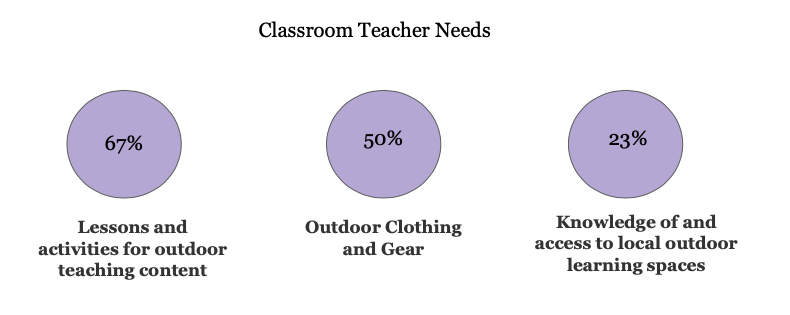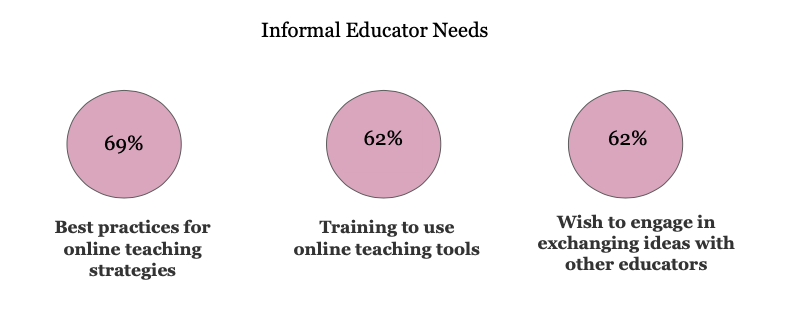Vermont classroom teachers along with outdoor, environmental and educational community partners pivoted quickly in March 2020 to provide fully remote learning opportunities for the remainder of the 2019-2020 school year. As teachers and students prepared for the 2020-2021 school year, there was uncertainty regarding the various distanced and remote learning structures that would be employed by schools. Local and national conversations among educators explored how COVID-19 safety guidelines would change instructional methods and learning spaces. One strategy became clear: outdoor classroom teaching and learning is a safe and effective alternative to indoor classroom teaching and learning, especially as the risk of COVID-19 growing during the winter months.
In response to the ongoing shifts and changing needs of Vermont classroom teachers and outdoor, environmental, and educational community partners, the Vermont Education and Environment Network sought to assess, understand, and respond to educator needs for the upcoming school year. North American Association for Environmental Education state affiliate groups in Georgia and Maine also conducted statewide surveys in an effort to identify and support the needs of educators in their states.
Methods
The Vermont Education and Environment Network used Survey Monkey to create an online survey of Vermont educators who work in a variety of settings, including pre-K-12 classroom teachers, outdoor and environmental educators, and educational community partners. Survey Monkey estimated survey the survey would take respondents six minutes to complete. The survey was active and accepted responses August 15-September 15, 2020.
After providing demographic information, including school or organization and location in Vermont, educators were asked to self identify as either a classroom teacher or an outdoor, environmental, or community partner educator. The survey then included a branching format to distinguish classroom teacher responses from outdoor, environmental and community partner educator responses. The two groups were asked the same questions and the branching allowed for analysis of the educators’ responses as an affinity group.
The survey asked about educational services each respondent was involved with providing pre-COVID; shifts in teaching implemented from March-June 2020; and educational approaches planned for fall 2020. Respondents were also asked about support needed to provide educational services during the 2020-21school year.
Using the Vermont Education and Environment Network email list, partner listservs, e-newsletters, and personal contacts, the survey was sent to over 600 individuals and organizations in Vermont identified as pre-K-12 classroom teachers, outdoor and environmental educators, and educational community partners. Recipients were encouraged to share the survey with colleagues and coworkers. A link to the survey was also posted on the Vermont Education and Environment Network website, and participation in the survey was encouraged during webinars with teacher and educator audiences.

Results
A total of 83 individuals began the survey and 59 completed the survey. Only completed surveys were used in the analyzed results presented in this article. The numbers in parenthesis in the map above indicate the number of classroom teacher respondents and number of informal educator respondents in each county.
Major shifts in response to COVID-19 activities for formal and informal educators included an increase in virtual instruction and a decrease in field trips and outdoor, environmental, and educational community partners programs. The image below shows the percent change in educational activities provided by Vermont classroom teachers and outdoor, environmental, and educational community partners due to COVID-19.

To adapt to the changes in practices necessitated by COVID-19 Vermont classroom teachers state they need support with virtual education content; appropriate outdoor clothing for students; and content and materials for teaching in outdoor classrooms.

Survey results showed that of the formal classroom teacher respondents 87% are teaching online and 67% said they are looking for lessons and activities for outdoor teaching content. In order to support outdoor learning 50% of classroom teachers identified a need for outdoor clothing and gear for their students and 23% expressed the need for knowledge of and access to local outdoor learning spaces.

The top needs of Vermont outdoor, environmental and educational community partners included 62% stating the need for training to use online teaching tools; 69% seek to apply best practices for online teaching strategies; and 62% wish to engage in exchanging ideas with other educators.
Many informal educators have experience teaching outdoors and can provide support and assistance. Building direct connections between school teachers and informal educators could improve the transfer of this information and materials. Additional outreach to connect informal educators with school teachers would be of benefit to both groups. A full inventory of outdoor equipment available for use by school teachers could improve the ability of school teachers to take students outside, while minimizing the risks presented by winter conditions.
Discussion
A few themes emerge when comparing the results of the survey conducted by the Environmental Education Alliance of Georgia (EEAG) and the Vermont Education and Environment Network Survey. Respondents from both surveys identified high quality outdoor activities and teaching resources as a top need: 59% of Georgia respondents said they need high quality teaching resources with activities kids can do outside, and 67% of Vermont respondents seek outdoor content. This was the number one need for Vermont classroom teachers. Additionally, respondents in both states identified a need for support in online learning: 48% of Georgia respondents identified a need for online teaching tips, whereas 69% of Vermont outdoor, environmental and educational community partners and 46% of classroom teachers identified a need to learn more about online teaching strategies. This was the top need identified by informal educators. Results from the Maine Environmental Education Association’s survey also show significant economic implications for organizations providing environmental and outdoor education with 51% of organizations shifting away from in person fee for service programming to free virtual programming.
Response
In response to the needs expressed by Vermont educators, the Vermont Education and Environment Network began a monthly webinar series in September 2020 on topics identified by educator respondents as priorities. Webinar topics have included support for virtual and outdoor classroom content; technology skills for online teaching and learning; and examples of successful outdoor teaching pedagogy.
A winter outdoor clothing drive is being held in an effort to address the lack of warm winter clothing and gear that may inhibit some students’ and classes’ abilities to safely and comfortably participate in outdoor learning activities during the winter months.
Our Vermont Education and Environment Network website and social media accounts are being more efficiently utilized to reach and communicate with educators around Vermont and beyond. We are using these platforms to build connections through our network of individuals and organizations working together to promote high quality outdoor, environmental, and educational experiences. Our website also offers opportunities to share educational resources; publicize our professional learning webinars, promote webinars by educational partners, and post job and grant funding opportunities relevant to educators.
We will continue to work with and identify the needs of Vermont educators both in the field and in the classroom. We plan to respond to their current and emerging needs through this pandemic and beyond.
View the complete survey results online
Authors: Ashley Eaton and Kerri McAllister
